Tourism and Society: Investigating the Effects on Community Life
VerifiedAdded on 2023/06/04
|8
|2754
|221
Essay
AI Summary
This essay provides a comprehensive analysis of the relationship between tourism and society, exploring the various impacts and dynamics at play. It begins by defining tourism and its significance to national economies, emphasizing its role in generating revenue, employment, and foreign exchange. The essay then delves into the sociological aspects of tourism, examining tourist behavior, motivations, and the cultural impacts on local communities. It discusses different tourism models, with a focus on Butler's Tourism Life Cycle model, detailing the stages of exploration, involvement, development, consolidation, stagnation, and decline. Furthermore, the essay utilizes the PESTEL analysis to evaluate the external factors influencing the tourism industry, including political, economic, social, technological, environmental, and legal aspects. It also touches upon tourist typologies, particularly Cohen's classification, and the interplay between culture and tourism. The essay concludes by summarizing the positive and negative impacts of tourism on society, highlighting the importance of sustainable and ethical practices within the industry. Desklib offers a range of similar essays and study tools for students.
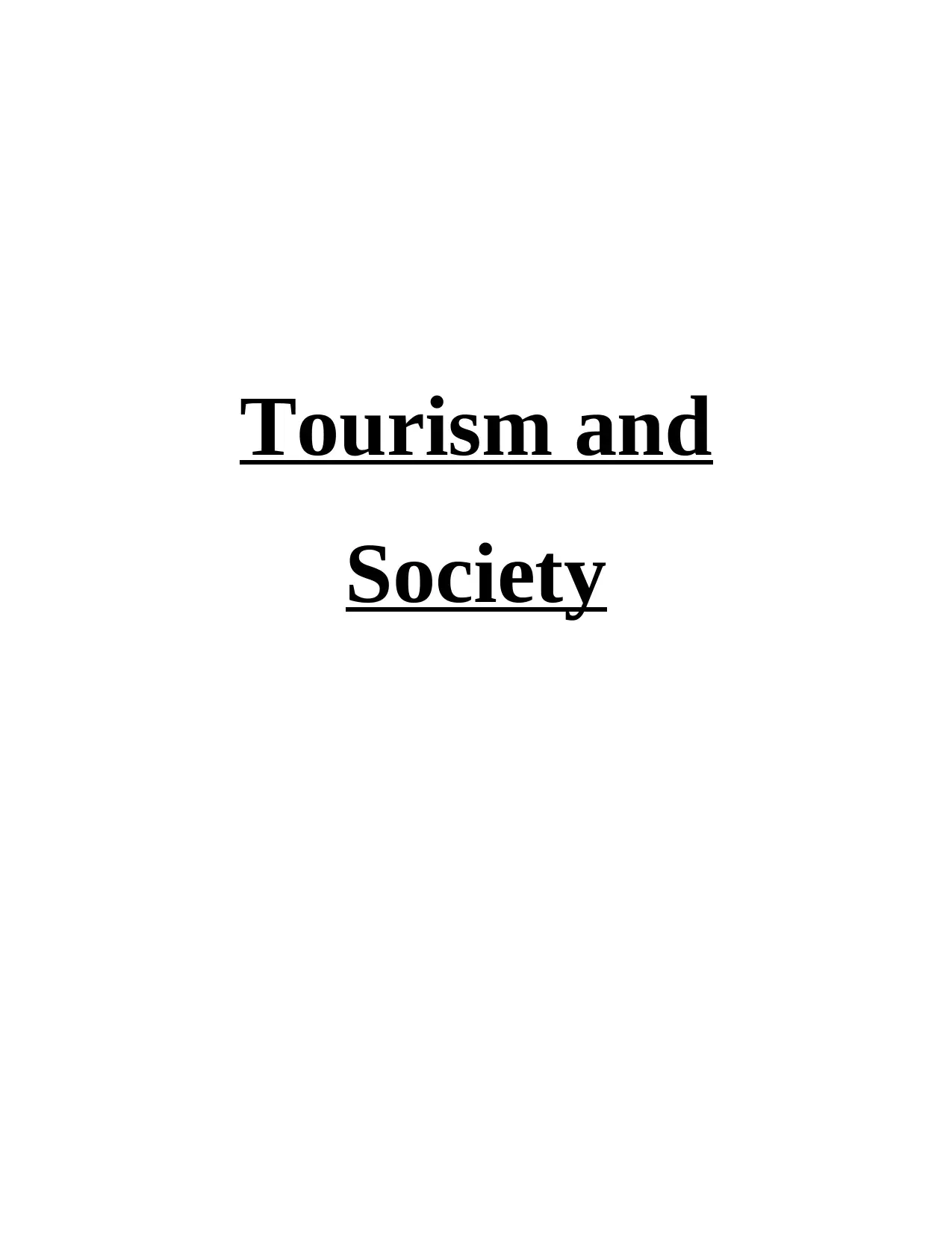
Tourism and
Society
Society
Paraphrase This Document
Need a fresh take? Get an instant paraphrase of this document with our AI Paraphraser

Contents
INTRODUCTION...........................................................................................................................1
MAIN BODY..................................................................................................................................1
CONCLUSION................................................................................................................................1
REFERENCES................................................................................................................................2
INTRODUCTION...........................................................................................................................1
MAIN BODY..................................................................................................................................1
CONCLUSION................................................................................................................................1
REFERENCES................................................................................................................................2

INTRODUCTION
This essay gives a detailed analysis about the Tourism and Society. The object of this
particular essay is to discuss about the relationship between tourism and society and what is the
impact of one on another. Tourism can be defined as a phenomena where an individual travels
for various different purpose which maybe personal like for relaxing or professional. It is an
activity which consist of all economic, social phenomenon and cultural aspect where a person
travels to unknown destination other than their residence (Fang, Zhang and Li, 2020). The main
benefit of tourism is to generate and boast revenue which makes it an essential factor for the
nations economy. It is very significant since it creates vast revenue, employment and wealth.
This clearly shows that tourism causes impact on economy and societal needs. Tourism is greatly
serving the nation since it creates the three most essential features required for goal oriented
developing nation i.e providing income, jobs and Foreign exchange. All theses result in
providing a quality life to the individual of that particular nation. The tourism industry though
represents huge profit generation but it is mostly dominated by the male and the female is
provided less in comparison to them. This biasness on the basis of sexual orientation causes a
negative impact on the tourism industry. The term sociology is described as a study of basic
interaction between the people which is studied in the context of social causes, challenges,
changes and the repercussions of human behaviour (Sharpley, 2018). The sociology of Tourism
talks about tourist relationship in relation to define roles, attitude, motivation, building
relationships between locals and tourists, cultural impact etc. With changing times and
advancement of technology, the needs of the tourist is also evolving now the tourist industry
must provide the same experience (Tzanelli and Korstanje, 2020). Due to Covid 19 pandemic hit
the nations world wide the concerned legislature, government and the local community of a state
also play an essential role in making laws and implementing the same regarding the tourism
industry.
MAIN BODY
The term tourism can be defined as a business which provides many services like lodging
at different places to various people consisting of facilities like accommodating, transfer, food
and beverage, etc. thereby giving a recreational and serene experience. There are mainly three
forms of tourism such as Domestic, Inbound and Outbound tourism. The tourism industry of the
1
This essay gives a detailed analysis about the Tourism and Society. The object of this
particular essay is to discuss about the relationship between tourism and society and what is the
impact of one on another. Tourism can be defined as a phenomena where an individual travels
for various different purpose which maybe personal like for relaxing or professional. It is an
activity which consist of all economic, social phenomenon and cultural aspect where a person
travels to unknown destination other than their residence (Fang, Zhang and Li, 2020). The main
benefit of tourism is to generate and boast revenue which makes it an essential factor for the
nations economy. It is very significant since it creates vast revenue, employment and wealth.
This clearly shows that tourism causes impact on economy and societal needs. Tourism is greatly
serving the nation since it creates the three most essential features required for goal oriented
developing nation i.e providing income, jobs and Foreign exchange. All theses result in
providing a quality life to the individual of that particular nation. The tourism industry though
represents huge profit generation but it is mostly dominated by the male and the female is
provided less in comparison to them. This biasness on the basis of sexual orientation causes a
negative impact on the tourism industry. The term sociology is described as a study of basic
interaction between the people which is studied in the context of social causes, challenges,
changes and the repercussions of human behaviour (Sharpley, 2018). The sociology of Tourism
talks about tourist relationship in relation to define roles, attitude, motivation, building
relationships between locals and tourists, cultural impact etc. With changing times and
advancement of technology, the needs of the tourist is also evolving now the tourist industry
must provide the same experience (Tzanelli and Korstanje, 2020). Due to Covid 19 pandemic hit
the nations world wide the concerned legislature, government and the local community of a state
also play an essential role in making laws and implementing the same regarding the tourism
industry.
MAIN BODY
The term tourism can be defined as a business which provides many services like lodging
at different places to various people consisting of facilities like accommodating, transfer, food
and beverage, etc. thereby giving a recreational and serene experience. There are mainly three
forms of tourism such as Domestic, Inbound and Outbound tourism. The tourism industry of the
1
⊘ This is a preview!⊘
Do you want full access?
Subscribe today to unlock all pages.

Trusted by 1+ million students worldwide
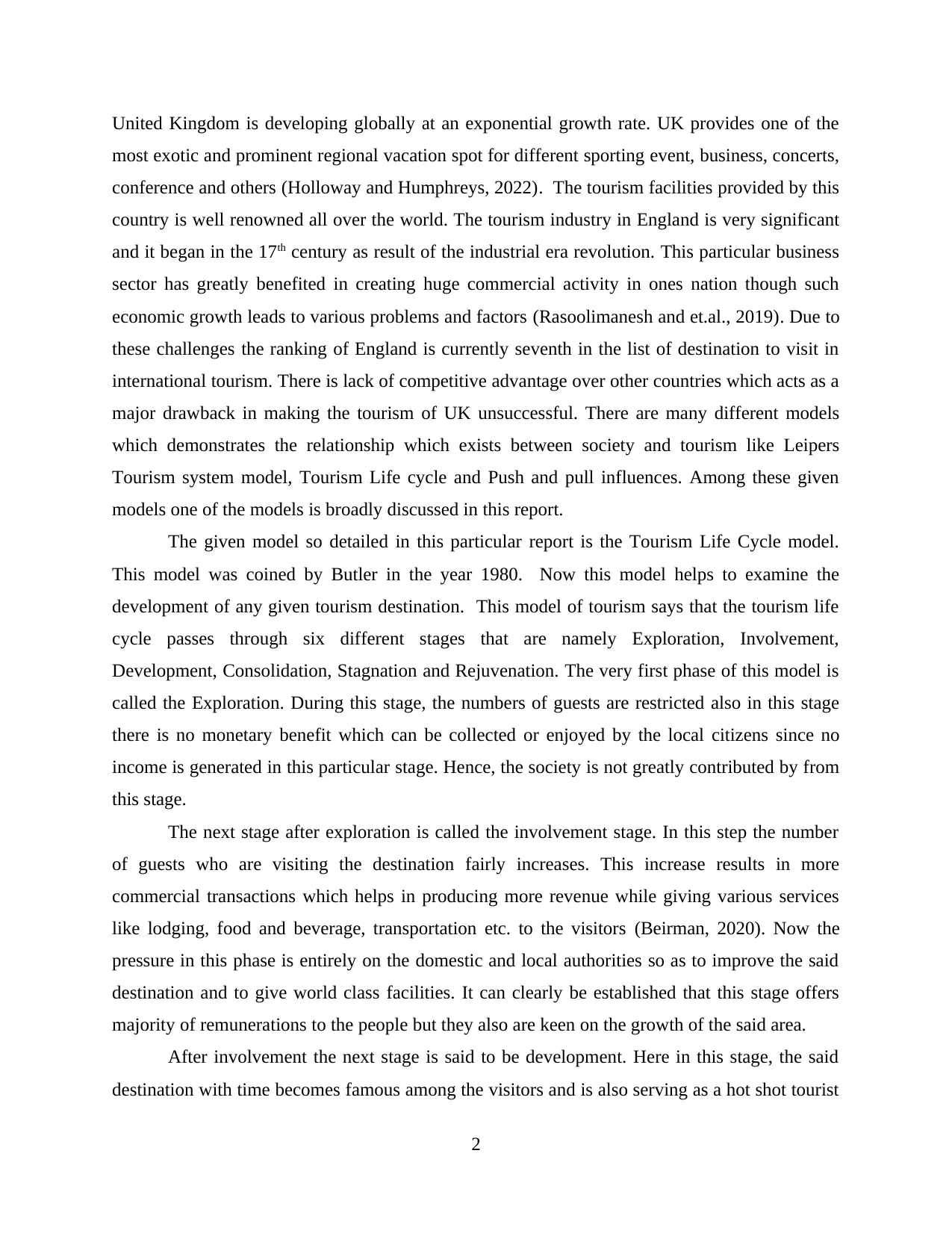
United Kingdom is developing globally at an exponential growth rate. UK provides one of the
most exotic and prominent regional vacation spot for different sporting event, business, concerts,
conference and others (Holloway and Humphreys, 2022). The tourism facilities provided by this
country is well renowned all over the world. The tourism industry in England is very significant
and it began in the 17th century as result of the industrial era revolution. This particular business
sector has greatly benefited in creating huge commercial activity in ones nation though such
economic growth leads to various problems and factors (Rasoolimanesh and et.al., 2019). Due to
these challenges the ranking of England is currently seventh in the list of destination to visit in
international tourism. There is lack of competitive advantage over other countries which acts as a
major drawback in making the tourism of UK unsuccessful. There are many different models
which demonstrates the relationship which exists between society and tourism like Leipers
Tourism system model, Tourism Life cycle and Push and pull influences. Among these given
models one of the models is broadly discussed in this report.
The given model so detailed in this particular report is the Tourism Life Cycle model.
This model was coined by Butler in the year 1980. Now this model helps to examine the
development of any given tourism destination. This model of tourism says that the tourism life
cycle passes through six different stages that are namely Exploration, Involvement,
Development, Consolidation, Stagnation and Rejuvenation. The very first phase of this model is
called the Exploration. During this stage, the numbers of guests are restricted also in this stage
there is no monetary benefit which can be collected or enjoyed by the local citizens since no
income is generated in this particular stage. Hence, the society is not greatly contributed by from
this stage.
The next stage after exploration is called the involvement stage. In this step the number
of guests who are visiting the destination fairly increases. This increase results in more
commercial transactions which helps in producing more revenue while giving various services
like lodging, food and beverage, transportation etc. to the visitors (Beirman, 2020). Now the
pressure in this phase is entirely on the domestic and local authorities so as to improve the said
destination and to give world class facilities. It can clearly be established that this stage offers
majority of remunerations to the people but they also are keen on the growth of the said area.
After involvement the next stage is said to be development. Here in this stage, the said
destination with time becomes famous among the visitors and is also serving as a hot shot tourist
2
most exotic and prominent regional vacation spot for different sporting event, business, concerts,
conference and others (Holloway and Humphreys, 2022). The tourism facilities provided by this
country is well renowned all over the world. The tourism industry in England is very significant
and it began in the 17th century as result of the industrial era revolution. This particular business
sector has greatly benefited in creating huge commercial activity in ones nation though such
economic growth leads to various problems and factors (Rasoolimanesh and et.al., 2019). Due to
these challenges the ranking of England is currently seventh in the list of destination to visit in
international tourism. There is lack of competitive advantage over other countries which acts as a
major drawback in making the tourism of UK unsuccessful. There are many different models
which demonstrates the relationship which exists between society and tourism like Leipers
Tourism system model, Tourism Life cycle and Push and pull influences. Among these given
models one of the models is broadly discussed in this report.
The given model so detailed in this particular report is the Tourism Life Cycle model.
This model was coined by Butler in the year 1980. Now this model helps to examine the
development of any given tourism destination. This model of tourism says that the tourism life
cycle passes through six different stages that are namely Exploration, Involvement,
Development, Consolidation, Stagnation and Rejuvenation. The very first phase of this model is
called the Exploration. During this stage, the numbers of guests are restricted also in this stage
there is no monetary benefit which can be collected or enjoyed by the local citizens since no
income is generated in this particular stage. Hence, the society is not greatly contributed by from
this stage.
The next stage after exploration is called the involvement stage. In this step the number
of guests who are visiting the destination fairly increases. This increase results in more
commercial transactions which helps in producing more revenue while giving various services
like lodging, food and beverage, transportation etc. to the visitors (Beirman, 2020). Now the
pressure in this phase is entirely on the domestic and local authorities so as to improve the said
destination and to give world class facilities. It can clearly be established that this stage offers
majority of remunerations to the people but they also are keen on the growth of the said area.
After involvement the next stage is said to be development. Here in this stage, the said
destination with time becomes famous among the visitors and is also serving as a hot shot tourist
2
Paraphrase This Document
Need a fresh take? Get an instant paraphrase of this document with our AI Paraphraser
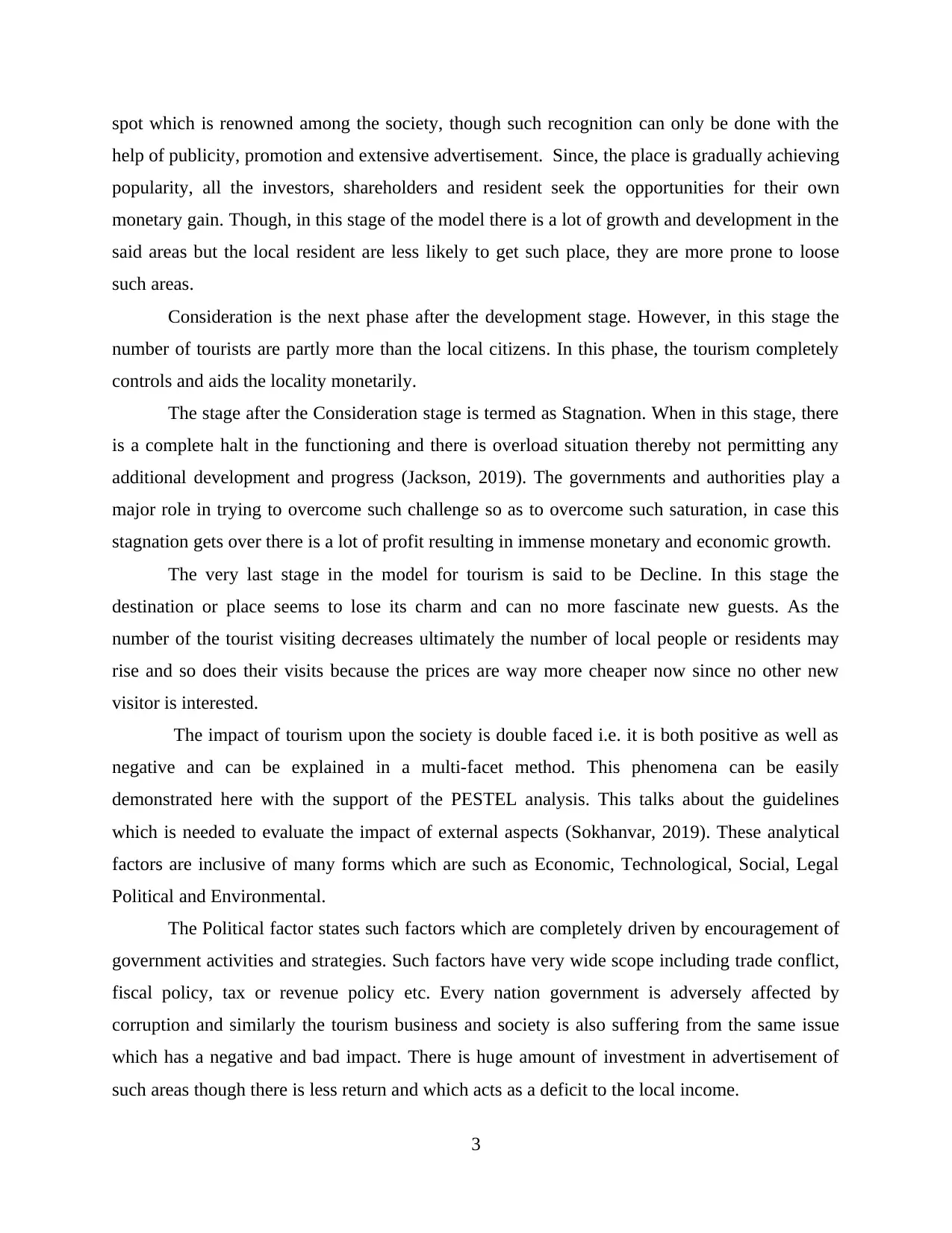
spot which is renowned among the society, though such recognition can only be done with the
help of publicity, promotion and extensive advertisement. Since, the place is gradually achieving
popularity, all the investors, shareholders and resident seek the opportunities for their own
monetary gain. Though, in this stage of the model there is a lot of growth and development in the
said areas but the local resident are less likely to get such place, they are more prone to loose
such areas.
Consideration is the next phase after the development stage. However, in this stage the
number of tourists are partly more than the local citizens. In this phase, the tourism completely
controls and aids the locality monetarily.
The stage after the Consideration stage is termed as Stagnation. When in this stage, there
is a complete halt in the functioning and there is overload situation thereby not permitting any
additional development and progress (Jackson, 2019). The governments and authorities play a
major role in trying to overcome such challenge so as to overcome such saturation, in case this
stagnation gets over there is a lot of profit resulting in immense monetary and economic growth.
The very last stage in the model for tourism is said to be Decline. In this stage the
destination or place seems to lose its charm and can no more fascinate new guests. As the
number of the tourist visiting decreases ultimately the number of local people or residents may
rise and so does their visits because the prices are way more cheaper now since no other new
visitor is interested.
The impact of tourism upon the society is double faced i.e. it is both positive as well as
negative and can be explained in a multi-facet method. This phenomena can be easily
demonstrated here with the support of the PESTEL analysis. This talks about the guidelines
which is needed to evaluate the impact of external aspects (Sokhanvar, 2019). These analytical
factors are inclusive of many forms which are such as Economic, Technological, Social, Legal
Political and Environmental.
The Political factor states such factors which are completely driven by encouragement of
government activities and strategies. Such factors have very wide scope including trade conflict,
fiscal policy, tax or revenue policy etc. Every nation government is adversely affected by
corruption and similarly the tourism business and society is also suffering from the same issue
which has a negative and bad impact. There is huge amount of investment in advertisement of
such areas though there is less return and which acts as a deficit to the local income.
3
help of publicity, promotion and extensive advertisement. Since, the place is gradually achieving
popularity, all the investors, shareholders and resident seek the opportunities for their own
monetary gain. Though, in this stage of the model there is a lot of growth and development in the
said areas but the local resident are less likely to get such place, they are more prone to loose
such areas.
Consideration is the next phase after the development stage. However, in this stage the
number of tourists are partly more than the local citizens. In this phase, the tourism completely
controls and aids the locality monetarily.
The stage after the Consideration stage is termed as Stagnation. When in this stage, there
is a complete halt in the functioning and there is overload situation thereby not permitting any
additional development and progress (Jackson, 2019). The governments and authorities play a
major role in trying to overcome such challenge so as to overcome such saturation, in case this
stagnation gets over there is a lot of profit resulting in immense monetary and economic growth.
The very last stage in the model for tourism is said to be Decline. In this stage the
destination or place seems to lose its charm and can no more fascinate new guests. As the
number of the tourist visiting decreases ultimately the number of local people or residents may
rise and so does their visits because the prices are way more cheaper now since no other new
visitor is interested.
The impact of tourism upon the society is double faced i.e. it is both positive as well as
negative and can be explained in a multi-facet method. This phenomena can be easily
demonstrated here with the support of the PESTEL analysis. This talks about the guidelines
which is needed to evaluate the impact of external aspects (Sokhanvar, 2019). These analytical
factors are inclusive of many forms which are such as Economic, Technological, Social, Legal
Political and Environmental.
The Political factor states such factors which are completely driven by encouragement of
government activities and strategies. Such factors have very wide scope including trade conflict,
fiscal policy, tax or revenue policy etc. Every nation government is adversely affected by
corruption and similarly the tourism business and society is also suffering from the same issue
which has a negative and bad impact. There is huge amount of investment in advertisement of
such areas though there is less return and which acts as a deficit to the local income.
3
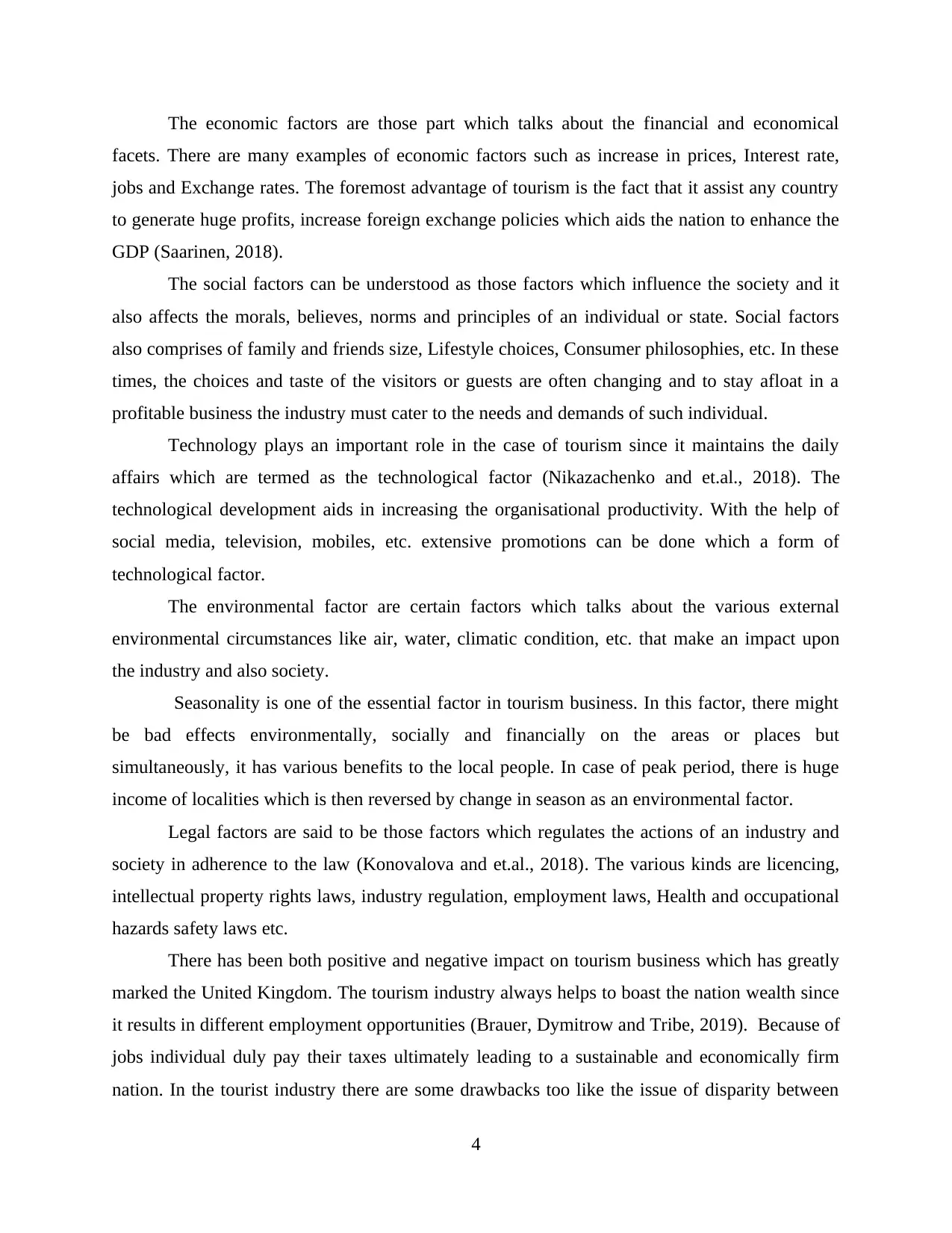
The economic factors are those part which talks about the financial and economical
facets. There are many examples of economic factors such as increase in prices, Interest rate,
jobs and Exchange rates. The foremost advantage of tourism is the fact that it assist any country
to generate huge profits, increase foreign exchange policies which aids the nation to enhance the
GDP (Saarinen, 2018).
The social factors can be understood as those factors which influence the society and it
also affects the morals, believes, norms and principles of an individual or state. Social factors
also comprises of family and friends size, Lifestyle choices, Consumer philosophies, etc. In these
times, the choices and taste of the visitors or guests are often changing and to stay afloat in a
profitable business the industry must cater to the needs and demands of such individual.
Technology plays an important role in the case of tourism since it maintains the daily
affairs which are termed as the technological factor (Nikazachenko and et.al., 2018). The
technological development aids in increasing the organisational productivity. With the help of
social media, television, mobiles, etc. extensive promotions can be done which a form of
technological factor.
The environmental factor are certain factors which talks about the various external
environmental circumstances like air, water, climatic condition, etc. that make an impact upon
the industry and also society.
Seasonality is one of the essential factor in tourism business. In this factor, there might
be bad effects environmentally, socially and financially on the areas or places but
simultaneously, it has various benefits to the local people. In case of peak period, there is huge
income of localities which is then reversed by change in season as an environmental factor.
Legal factors are said to be those factors which regulates the actions of an industry and
society in adherence to the law (Konovalova and et.al., 2018). The various kinds are licencing,
intellectual property rights laws, industry regulation, employment laws, Health and occupational
hazards safety laws etc.
There has been both positive and negative impact on tourism business which has greatly
marked the United Kingdom. The tourism industry always helps to boast the nation wealth since
it results in different employment opportunities (Brauer, Dymitrow and Tribe, 2019). Because of
jobs individual duly pay their taxes ultimately leading to a sustainable and economically firm
nation. In the tourist industry there are some drawbacks too like the issue of disparity between
4
facets. There are many examples of economic factors such as increase in prices, Interest rate,
jobs and Exchange rates. The foremost advantage of tourism is the fact that it assist any country
to generate huge profits, increase foreign exchange policies which aids the nation to enhance the
GDP (Saarinen, 2018).
The social factors can be understood as those factors which influence the society and it
also affects the morals, believes, norms and principles of an individual or state. Social factors
also comprises of family and friends size, Lifestyle choices, Consumer philosophies, etc. In these
times, the choices and taste of the visitors or guests are often changing and to stay afloat in a
profitable business the industry must cater to the needs and demands of such individual.
Technology plays an important role in the case of tourism since it maintains the daily
affairs which are termed as the technological factor (Nikazachenko and et.al., 2018). The
technological development aids in increasing the organisational productivity. With the help of
social media, television, mobiles, etc. extensive promotions can be done which a form of
technological factor.
The environmental factor are certain factors which talks about the various external
environmental circumstances like air, water, climatic condition, etc. that make an impact upon
the industry and also society.
Seasonality is one of the essential factor in tourism business. In this factor, there might
be bad effects environmentally, socially and financially on the areas or places but
simultaneously, it has various benefits to the local people. In case of peak period, there is huge
income of localities which is then reversed by change in season as an environmental factor.
Legal factors are said to be those factors which regulates the actions of an industry and
society in adherence to the law (Konovalova and et.al., 2018). The various kinds are licencing,
intellectual property rights laws, industry regulation, employment laws, Health and occupational
hazards safety laws etc.
There has been both positive and negative impact on tourism business which has greatly
marked the United Kingdom. The tourism industry always helps to boast the nation wealth since
it results in different employment opportunities (Brauer, Dymitrow and Tribe, 2019). Because of
jobs individual duly pay their taxes ultimately leading to a sustainable and economically firm
nation. In the tourist industry there are some drawbacks too like the issue of disparity between
4
⊘ This is a preview!⊘
Do you want full access?
Subscribe today to unlock all pages.

Trusted by 1+ million students worldwide
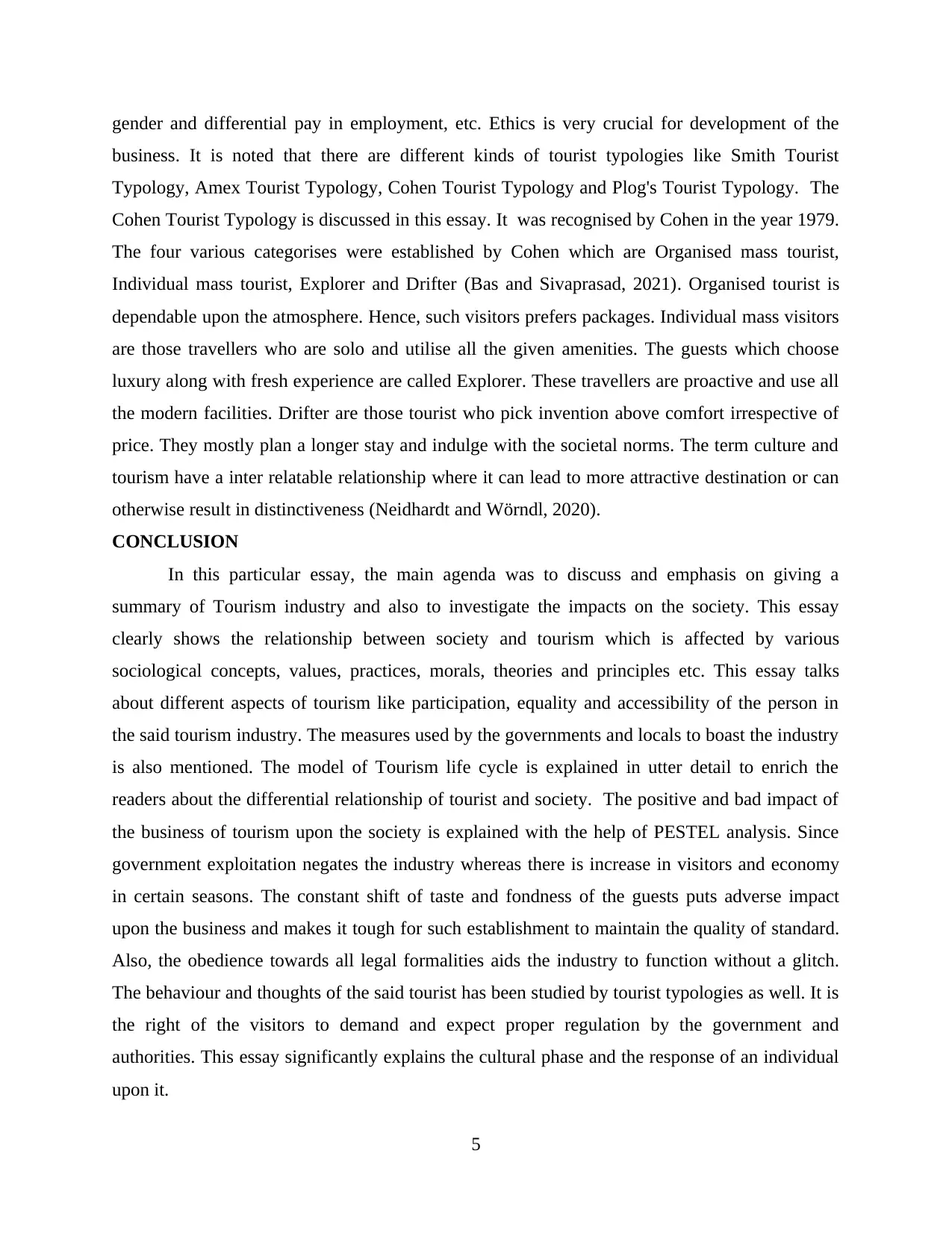
gender and differential pay in employment, etc. Ethics is very crucial for development of the
business. It is noted that there are different kinds of tourist typologies like Smith Tourist
Typology, Amex Tourist Typology, Cohen Tourist Typology and Plog's Tourist Typology. The
Cohen Tourist Typology is discussed in this essay. It was recognised by Cohen in the year 1979.
The four various categorises were established by Cohen which are Organised mass tourist,
Individual mass tourist, Explorer and Drifter (Bas and Sivaprasad, 2021). Organised tourist is
dependable upon the atmosphere. Hence, such visitors prefers packages. Individual mass visitors
are those travellers who are solo and utilise all the given amenities. The guests which choose
luxury along with fresh experience are called Explorer. These travellers are proactive and use all
the modern facilities. Drifter are those tourist who pick invention above comfort irrespective of
price. They mostly plan a longer stay and indulge with the societal norms. The term culture and
tourism have a inter relatable relationship where it can lead to more attractive destination or can
otherwise result in distinctiveness (Neidhardt and Wörndl, 2020).
CONCLUSION
In this particular essay, the main agenda was to discuss and emphasis on giving a
summary of Tourism industry and also to investigate the impacts on the society. This essay
clearly shows the relationship between society and tourism which is affected by various
sociological concepts, values, practices, morals, theories and principles etc. This essay talks
about different aspects of tourism like participation, equality and accessibility of the person in
the said tourism industry. The measures used by the governments and locals to boast the industry
is also mentioned. The model of Tourism life cycle is explained in utter detail to enrich the
readers about the differential relationship of tourist and society. The positive and bad impact of
the business of tourism upon the society is explained with the help of PESTEL analysis. Since
government exploitation negates the industry whereas there is increase in visitors and economy
in certain seasons. The constant shift of taste and fondness of the guests puts adverse impact
upon the business and makes it tough for such establishment to maintain the quality of standard.
Also, the obedience towards all legal formalities aids the industry to function without a glitch.
The behaviour and thoughts of the said tourist has been studied by tourist typologies as well. It is
the right of the visitors to demand and expect proper regulation by the government and
authorities. This essay significantly explains the cultural phase and the response of an individual
upon it.
5
business. It is noted that there are different kinds of tourist typologies like Smith Tourist
Typology, Amex Tourist Typology, Cohen Tourist Typology and Plog's Tourist Typology. The
Cohen Tourist Typology is discussed in this essay. It was recognised by Cohen in the year 1979.
The four various categorises were established by Cohen which are Organised mass tourist,
Individual mass tourist, Explorer and Drifter (Bas and Sivaprasad, 2021). Organised tourist is
dependable upon the atmosphere. Hence, such visitors prefers packages. Individual mass visitors
are those travellers who are solo and utilise all the given amenities. The guests which choose
luxury along with fresh experience are called Explorer. These travellers are proactive and use all
the modern facilities. Drifter are those tourist who pick invention above comfort irrespective of
price. They mostly plan a longer stay and indulge with the societal norms. The term culture and
tourism have a inter relatable relationship where it can lead to more attractive destination or can
otherwise result in distinctiveness (Neidhardt and Wörndl, 2020).
CONCLUSION
In this particular essay, the main agenda was to discuss and emphasis on giving a
summary of Tourism industry and also to investigate the impacts on the society. This essay
clearly shows the relationship between society and tourism which is affected by various
sociological concepts, values, practices, morals, theories and principles etc. This essay talks
about different aspects of tourism like participation, equality and accessibility of the person in
the said tourism industry. The measures used by the governments and locals to boast the industry
is also mentioned. The model of Tourism life cycle is explained in utter detail to enrich the
readers about the differential relationship of tourist and society. The positive and bad impact of
the business of tourism upon the society is explained with the help of PESTEL analysis. Since
government exploitation negates the industry whereas there is increase in visitors and economy
in certain seasons. The constant shift of taste and fondness of the guests puts adverse impact
upon the business and makes it tough for such establishment to maintain the quality of standard.
Also, the obedience towards all legal formalities aids the industry to function without a glitch.
The behaviour and thoughts of the said tourist has been studied by tourist typologies as well. It is
the right of the visitors to demand and expect proper regulation by the government and
authorities. This essay significantly explains the cultural phase and the response of an individual
upon it.
5
Paraphrase This Document
Need a fresh take? Get an instant paraphrase of this document with our AI Paraphraser
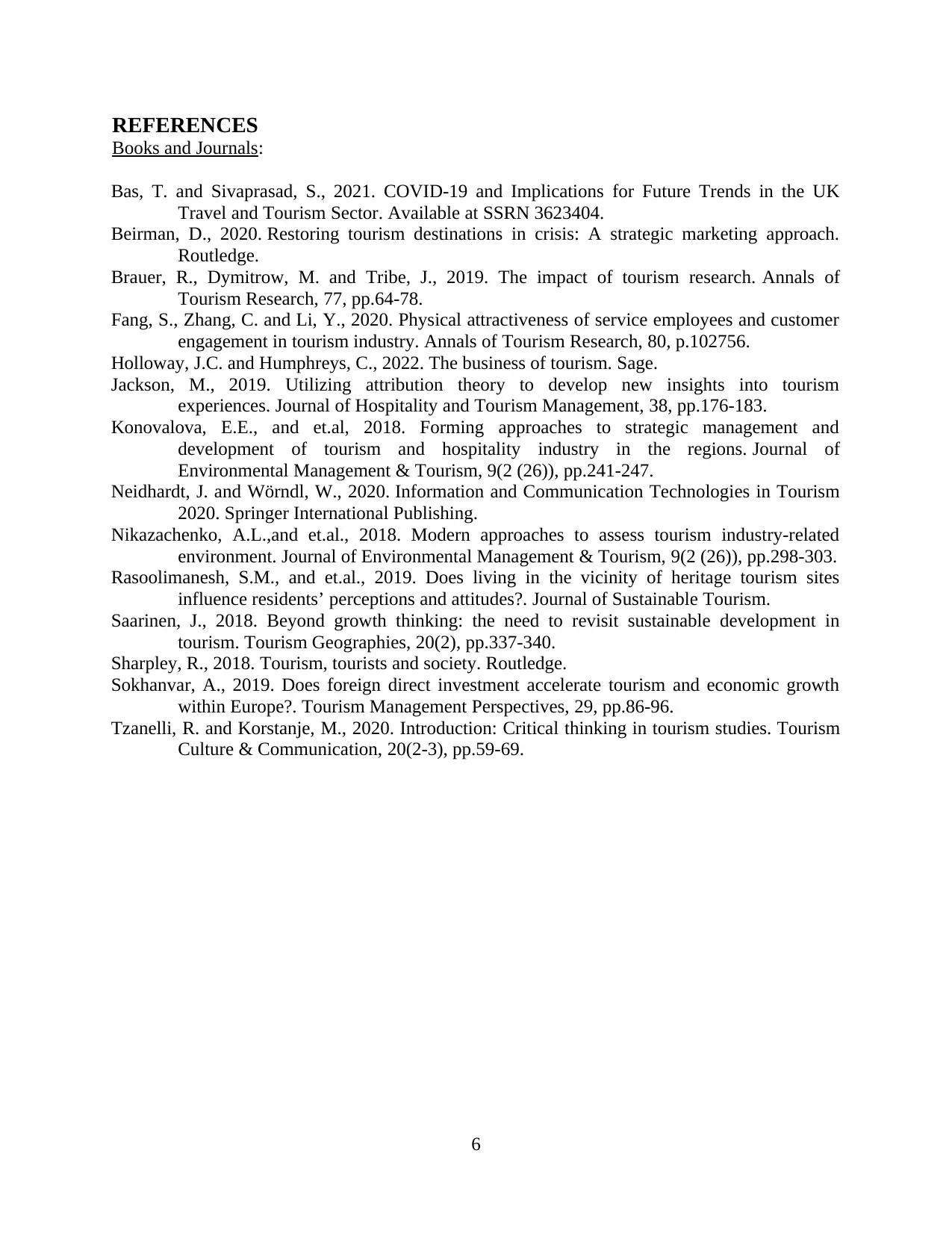
REFERENCES
Books and Journals:
Bas, T. and Sivaprasad, S., 2021. COVID-19 and Implications for Future Trends in the UK
Travel and Tourism Sector. Available at SSRN 3623404.
Beirman, D., 2020. Restoring tourism destinations in crisis: A strategic marketing approach.
Routledge.
Brauer, R., Dymitrow, M. and Tribe, J., 2019. The impact of tourism research. Annals of
Tourism Research, 77, pp.64-78.
Fang, S., Zhang, C. and Li, Y., 2020. Physical attractiveness of service employees and customer
engagement in tourism industry. Annals of Tourism Research, 80, p.102756.
Holloway, J.C. and Humphreys, C., 2022. The business of tourism. Sage.
Jackson, M., 2019. Utilizing attribution theory to develop new insights into tourism
experiences. Journal of Hospitality and Tourism Management, 38, pp.176-183.
Konovalova, E.E., and et.al, 2018. Forming approaches to strategic management and
development of tourism and hospitality industry in the regions. Journal of
Environmental Management & Tourism, 9(2 (26)), pp.241-247.
Neidhardt, J. and Wörndl, W., 2020. Information and Communication Technologies in Tourism
2020. Springer International Publishing.
Nikazachenko, A.L.,and et.al., 2018. Modern approaches to assess tourism industry-related
environment. Journal of Environmental Management & Tourism, 9(2 (26)), pp.298-303.
Rasoolimanesh, S.M., and et.al., 2019. Does living in the vicinity of heritage tourism sites
influence residents’ perceptions and attitudes?. Journal of Sustainable Tourism.
Saarinen, J., 2018. Beyond growth thinking: the need to revisit sustainable development in
tourism. Tourism Geographies, 20(2), pp.337-340.
Sharpley, R., 2018. Tourism, tourists and society. Routledge.
Sokhanvar, A., 2019. Does foreign direct investment accelerate tourism and economic growth
within Europe?. Tourism Management Perspectives, 29, pp.86-96.
Tzanelli, R. and Korstanje, M., 2020. Introduction: Critical thinking in tourism studies. Tourism
Culture & Communication, 20(2-3), pp.59-69.
6
Books and Journals:
Bas, T. and Sivaprasad, S., 2021. COVID-19 and Implications for Future Trends in the UK
Travel and Tourism Sector. Available at SSRN 3623404.
Beirman, D., 2020. Restoring tourism destinations in crisis: A strategic marketing approach.
Routledge.
Brauer, R., Dymitrow, M. and Tribe, J., 2019. The impact of tourism research. Annals of
Tourism Research, 77, pp.64-78.
Fang, S., Zhang, C. and Li, Y., 2020. Physical attractiveness of service employees and customer
engagement in tourism industry. Annals of Tourism Research, 80, p.102756.
Holloway, J.C. and Humphreys, C., 2022. The business of tourism. Sage.
Jackson, M., 2019. Utilizing attribution theory to develop new insights into tourism
experiences. Journal of Hospitality and Tourism Management, 38, pp.176-183.
Konovalova, E.E., and et.al, 2018. Forming approaches to strategic management and
development of tourism and hospitality industry in the regions. Journal of
Environmental Management & Tourism, 9(2 (26)), pp.241-247.
Neidhardt, J. and Wörndl, W., 2020. Information and Communication Technologies in Tourism
2020. Springer International Publishing.
Nikazachenko, A.L.,and et.al., 2018. Modern approaches to assess tourism industry-related
environment. Journal of Environmental Management & Tourism, 9(2 (26)), pp.298-303.
Rasoolimanesh, S.M., and et.al., 2019. Does living in the vicinity of heritage tourism sites
influence residents’ perceptions and attitudes?. Journal of Sustainable Tourism.
Saarinen, J., 2018. Beyond growth thinking: the need to revisit sustainable development in
tourism. Tourism Geographies, 20(2), pp.337-340.
Sharpley, R., 2018. Tourism, tourists and society. Routledge.
Sokhanvar, A., 2019. Does foreign direct investment accelerate tourism and economic growth
within Europe?. Tourism Management Perspectives, 29, pp.86-96.
Tzanelli, R. and Korstanje, M., 2020. Introduction: Critical thinking in tourism studies. Tourism
Culture & Communication, 20(2-3), pp.59-69.
6
1 out of 8
Related Documents
Your All-in-One AI-Powered Toolkit for Academic Success.
+13062052269
info@desklib.com
Available 24*7 on WhatsApp / Email
![[object Object]](/_next/static/media/star-bottom.7253800d.svg)
Unlock your academic potential
Copyright © 2020–2025 A2Z Services. All Rights Reserved. Developed and managed by ZUCOL.



